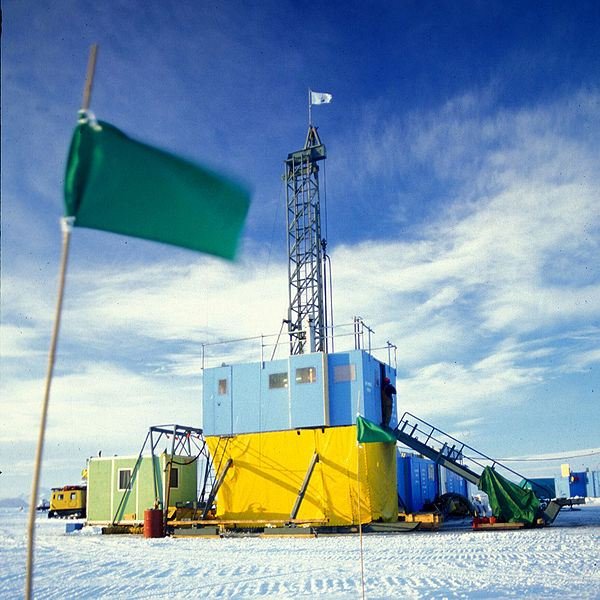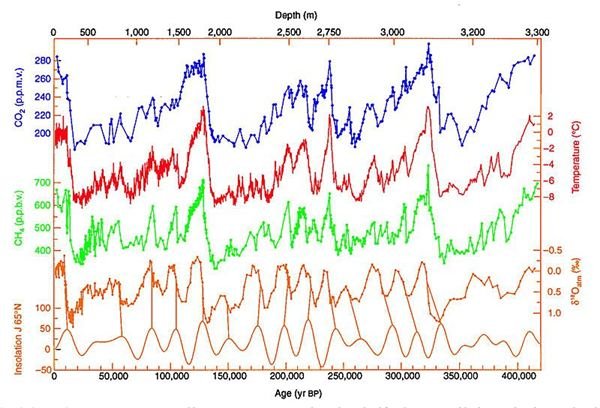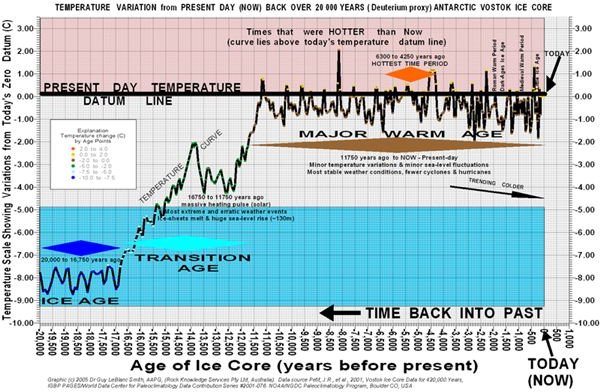What Can Ice Cores with High Co2 Levels Tell About Future Global Warming?
What Do Ice Cores Tell Scientists About the Past?
Ice cores are samples of ice layers that have piled and accumulated through years of snowfall taken from the cold freezing regions of Antarctica, Greenland and Siberia. The cross section of each ice core will reveal the number of layers which more or less represents the number of years that have passed before they were cored and taken as samples. Since much of the trapped particles, elements and gases are evidence of the past, ice cores tell us about past climate change patterns and that future global warming and global cooling are natural phenomena that occur as cyclical changes.
Natural CO2 and other greenhouses gases are essential to Earth’s existence as a way of warming the planet’s atmosphere. Based on previous ice core analysis, if the Earth is devoid of natural greenhouse gases and natural warming, the temperature would be 0 degrees Fahrenheit.
Ice core records gathered by scientists show that the amount of Co2 during the Age of Industrialization, around 1750s, was measured at 275 parts for every million. Industrialization began during the 1700s when textile manufacture was on the rise, more so when the cotton gin machine was invented by Eli Whitney.
To date, Co2 in the atmosphere has increased by 30% or at 350 parts per million and still rising. Actually, everything is expected to rise in proportion. Records showed that when the levels of greenhouse gases increased, ice sheets began to melt followed by the rise of sea water levels.
Click on the image above for a larger view of a graph showing records of global warming and global cooling in different areas.
Ice Core Drilling Projects

Today, an ice drilling project called the North Greenland Eemian Ice Drilling, or NEEM, participated in by 14 nations aim to retrieve ice core samples from the last Interglacial phase that the Earth went into. This was called the Eemian Period wherein the ice samples extracted, showed warmer temperatures than what the Earth is experiencing today. This was supported by the fact that during that time, there was less ice in Greenland while the sea level was higher than 15,000 feet than what it is today.
The NEEM project‘s radar measurements have pinned down sites where thicker Eemian ice layers can be found and drilled. This will provide them with more specific information on what to expect about the global warming in our midst. Presently, there is much evidence to believe that the Earth is experiencing global warming patterns based on the samples unearthed inside every layer of the ice cores. If patterns are to be followed, the planet is still in for another 10,000 years of unpredictable climate changes, where extreme global warming or global cooling will take place.
What scientists are worried about is that the levels of Co2 concentrations today are much higher than the levels found in the ice core samples of before. If ice melted faster then and that sea level was higher by 15,000 feet under previous global warming conditions, then the 30% increase of Co2 levels in the atmosphere can be expected to bring on a proportionate increase in ice melt and sea water rising.
As global temperature increases, the speed by which glaciers and ice sheets melt also increases and this will hasten the transition into full global warming stage. Whereas CO2 levels observed from hundreds of thousands of prior years were not too significant in amounts, the current Co2 and other greenhouse gases accumulated through modern day human activity have added to the Earth’s atmosphere. This denotes that we have actual cause for concern.
How Do Scientists Use Ice Core Data?

What we can expect in the future could be more than double the significance of the data gathered from the Eemian ice core samples. Our human activities have contributed more Co2 and greenhouse gases than the Earth naturally produces. Hence, what ice cores tell us about the future is the process by which the Earth will enter the full global warming state.
Daily temperatures for the past 150 years have been taken into account and it has been established that the Earth’s temperature increased by.5 degrees Celsius or by half a degree. Climatologists, who are more concerned about future climates, have come up with climate models that will show the possible effects of the temperature’s increase. Instead of using the .5 degrees Celsius, a full one degree increase was used for the models. Climatologists were initially concerned that the accuracy of increasing the temperature by twice the value of their data may cause some alarm.
What Climate Models Tell About the Future?

As paleoclimatologists continue to observe what is currently transpiring in the environment, they are seeing all the suggested consequences produced by their climate models happening to a certain degree. Ice glaciers have been receding at a fast pace with corresponding rises in sea levels. Dying coral reefs, plant and animal extinction are due to what they call, “extreme precipitation events”. In layman’s terms, this refers to extreme rains, typhoons or storms leading to extraordinary levels of flooding. These have all occurred in every part of the globe.
Climate models and actual events are compared and have strengthened the evidence that the Earth is indeed experiencing global warming. The question is, “How soon do we expect to leave the phase of stable climate condition in this Interglacial Cycle that we are now in? Or have we already seen the end of the stable climate condition and in fact have already entered the erratic phases of global warming and global cooling?”
Actually, it is not so much as the rate by which we are exiting the stage of stable climate condition that should make us concerned. The effects of rapid ice meltdowns and rising sea levels have presented several scenarios that scientists have seen in their studies of the ice cores. A total meltdown will uncover what was trapped beneath the ice layers and it includes the fungus and microbes that could date back to ancient times. These microorganisms will re-emerge and will thrive in the Earth’s new temperature and are likely to bring about airborne diseases.
The rise in sea levels which ice core samples show to have reached 15,000 feet higher than what it is today will likely reach or surpass the same levels. Coastal towns, low lying islands and communities near river deltas are likely to submerge in water. If global warming heat will bring about extreme precipitations, then rainfall, typhoons, or storms will bring down large amounts of water on land that will flood the mainland because the rain water run-offs have nowhere to go. Coastlines and river deltas are already high with sea water. Actually, these occurrences have not escaped the observations of scientists as already happening.
Perhaps, somehow paleoclimatologists would prefer that the accuracy of their studies about ice cores and past climate changes will be proven wrong rather than be validated by what is actually happening.
References:
- https://www.carc.org/pubs/v15no5/4.htm
- https://www.essortment.com/all/globalwarmingc_rnkz.htm
- https://www.colorado.edu/news/r/d293a239083e3826bcc014e5df4671f7.html
Image Credit:
- All images are courtesy of Wikimedia commons.
This post is part of the series: Ice Cores
Ice cores are samples of snow sheets that contain information about gases and particulate matters brought down by snowfalls that become permanently trapped in ice. This data has helped scientists learn about global climate changes, for both past, present and future. Find out more in this series.
